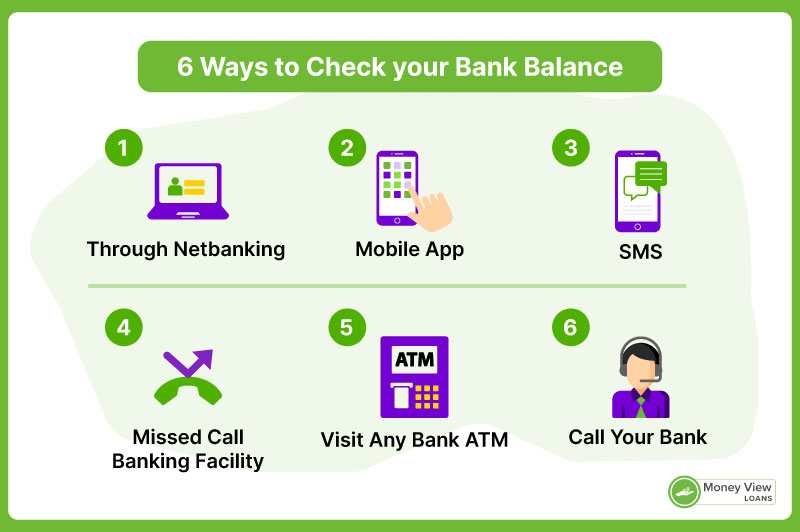It is essential that you are aware of the total amount of money available within your bank account. If you check your account regularly, you will have a better idea of your finances and will be able to identify potential issues before they spiral out of control.
When you have finished viewing your balance, you should ensure that you fully comprehend the distinction between the balance of your account and the available balance.
Checking your account balance can be done in 6 simple ways
1. Log In Online
One can check the balance of their account at any time online, in addition to many other things. Go to your bank's website and then access the information about your accounts there. There is also the option of using a mobile app, which we will discuss further down. You should, in the majority of instances, look for a choice that reads "Login" or "Account Access." Choose one of the "Register" or "First-time User" options if this is your first time using the site.
2. Mobile applications and text message communication
The ability to check on accounts using tablets, mobile phones, and other devices makes it simple to do so from virtually any location. The vast majority of financial institutions now offer downloadable applications (or at the very least, mobile-friendly versions of their websites) that make it possible to check your account balance both online and while you are away from home.
Setting up text messaging with your financial institution is the quickest way. If your bank provides this feature, all you have to do is make a request.
3. Make use of an ATM machine
Automatic Teller Machines are able to provide up-to-date account balances. Insert your debit card or ATM card, and then follow the instructions that appear on the screen. It is highly recommended that you use the ATM of your own bank. It's possible that your bank will charge you a fee for using a "different" ATM, which means that checking your balance could end up costing you money.
4. Make a call to the bank
Calling to ask about your account balance is an option for those who favor more conventional methods. If you want to speak with a real person, you will probably have to call at certain hours; however, the majority of banks do make use of automated systems which give you account information around the clock. Once you have everything set up, it will become second nature.
5. Set Up Alerts
You can prevent yourself from having to manually check your bank account balances by requesting that your bank send you the information whenever something occurs to your account. This will add an additional layer of automatic protection to your account.
Do you want to be notified when a significant withdrawal is made from your account or when the balance in your account gets dangerously low? In that case, you should tell your bank to send you a notification when certain events occur.
Even if you have alerts set up, it is still a good idea to check in on your account at regular intervals. You are required to immediately report any errors that may have occurred and any fraudulent transactions to receive the full protection afforded to you by federal law.
6. Contact a Bank Teller
Try speaking with someone personally. Unfortunately, access to tellers is becoming more difficult.
Although having a conversation in person can be informative, it is in your best interest to become familiar with the other options listed above.
Your Available Balance
When you log into your bank account online or on the mobile banking app, most financial institutions will display your total account balance and your available balance. The available balance shown will tell you the amount of money you have available to spend or withdraw today.
Because of pending transactions, such as debit card authorizations, upcoming bill payments, and deposits that have not yet cleared, the available balance often is typically less than what you think you have. This is because the available balance takes into account cleared deposits. The possibility exists that these funds will become accessible in the next few days; however, until that time, the funds will remain frozen.
You Know About Your Money More Than Your Financial Institution Does
If you keep your account balance on a regular basis, you will have little requirement to check up on your balance. In point of fact, you will most likely be aware of how your balance will turn out even before the bank does.
Frequently Asked Questions (FAQs)
In what ways can one monitor the balance in one's checking account?
You have a number of options available to you for keeping an eye on your account. Make use of mobile apps that keep all details at the tips of your fingers, and set up alerts so that the bank can inform you of any potential issues as soon as they arise. You'll better understand your finances if you keep track of everything.
Which financial institution is the most advisable for an account with no balance?
Your preferences will determine which financial institution is the best fit for you. On the other hand, if you anticipate having balances which are low, you will want to make sure that the bank account you choose does not have any account minimums or perhaps monthly fees which could inadvertently result in an overdraft fee being assessed.
What consequences are there for closing a bank account when there is an existing deficit in the account?
If you go over the limit on your checking account and have a negative balance, you are expected to pay back the money you owe to the bank. If you make a formal request regarding closing your account, the financial institution almost certainly won't comply with your request until the account's balance is at least equal to zero once again.


